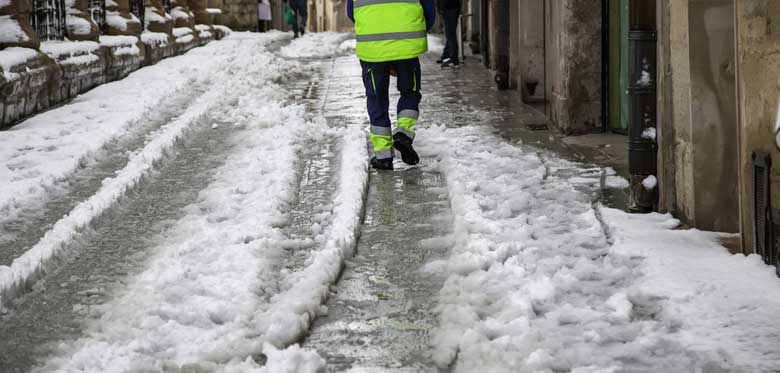It is no surprise that slips and falls increase significantly in the workplace over the autumn and winter months. The days are shorter and people are going to and leaving work in the dark and as the weather deteriorates, ice and snow can cause tripping hazards both if working outdoors but also on the routes to and from workplaces.
What should your employer be doing?
If ice and snow are forecast then your employer should ensure that walkways and pedestrian entrances for their employees are gritted properly to avoid falls. Grit (or rock salt) takes some time to work and so best practice is to grit the evening before the temperatures are forecast to dip to freezing and to do it again in the morning before the workforce is scheduled to arrive.
A responsible employer should have a winter weather policy and will carry out risk assessments to identify any areas in or around their property or site which might be more vulnerable to inclement weather conditions, i.e. paths under overhanging trees which may have leaves falling onto to them and then decaying on the ground. Other potential hazards include blocked gutters causing excessive rainwater to drip onto pathways, areas which are constantly in the shade and have excessive moss and algae growing on them, and areas of poor lighting where it might not be possible to see a build up of leaves, or ice and snow. They should ensure that drainage grids are free-flowing and not blocked, to prevent excess water spilling out.
Your employer’s winter or inclement weather risk assessment should aim to identify any potential hazards to their staff working outside, or making their way in and out of the workplace buildings, and to take steps to reduce those hazards to the lowest possible level.
What preventative actions can be taken?
- Gritting or putting down rock salt when icy conditions are forecast
- Making sure that outdoor paths and pedestrian walkways are cleared regularly of a build-up of moss/algae/decaying plant matter
- Prune back overhanging shrubs and trees where possible
- Ensure that entrances to buildings have suitable non-slip matting or floor materials to soak up excess water being brought in from outside
- Put out wet floor signs at building entrances in inclement weather
- Make sure that employees are aware of the firm’s inclement weather policy
- Consider any problematic areas around the site or workplace and review to see if alternative routes can be used, or if changes can be invested in to make those areas non-slip
- Using suitable non-slip materials for pathways around sites where possible.
What can you do as an employee?
- Report any accidents or near misses to your employer immediately
- Wear appropriate, sturdy non-slip footwear when working outdoors
- Familiarise yourself with your firm’s risk assessment and winter/wet weather policy
- If you see any potential hazards, i.e. a build-up of leaves on a designated path, or a blocked drainage point, report this – prevention is better than cure
If you have suffered an accident at work due to adverse weather conditions and you would like some advice on whether you are able to claim against your employer, please contact our personal injury team on 0161 696 6235.




Comments